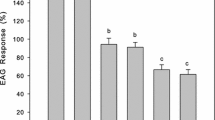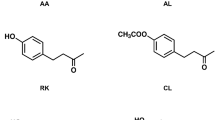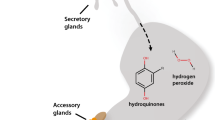Abstract
North American beaver (Castor canadensis) mark their territories with castoreum, a chemically complex secretion from their castor sacs. The phenolic and neutral fractions of castoreum have been shown to elicit specific behavioral responses from beavers in a field setting. Our objective was to identify compounds/mixtures that evoked responses similar to those stimulated by castoreum. We assayed recently identified phenolic compounds, some phenolics that had been determined to be biologically active in previous studies, the neutral compound borneol, and combinations of phenolic compounds, neutral compounds, and the two combined. Biological activity was measured by the elicitation and extent of specific responses and their strength (duration, frequency, and proportion of beavers responding). Generally, single compounds stimulated fewer responses than mixtures. A 26-compound mixture of phenolic and neutral compounds elicited responses in a similar proportion of trials as castoreum. However, responses to castoreum were stronger than to any synthetic sample. Further investigation of different measures of response, namely, elicitation, completeness, and strength, are deemed necessary to fully decipher the design of social odors.
Similar content being viewed by others
References
Alberts, A.C. 1992. Constraints on the design of chemical communication systems in terrestrial vertebrates.Am. Nat. 139:S62-S89.
Albone, C.S. 1984. Mammalian Semiochemistry. Wiley Interscience, Chicester.
Beauchamp, G.K., Doty, R.L., Moulton, D.G., andMugford, R.A. 1976. The pheromone concept in mammalian chemical communication: A brief critique, pp. 143–160,in R.L. Doty (ed.). Mammalian Olfaction, Reproductive Processes and Behavior. Academic Press, New York.
Belcher, A., Epple, G., Küderling, I., andSmith, A.B., III. 1988. Volatile components of scent material from cotton-top tamarin (Saguinus o. oedipus): A chemical and behavioral study.J. Chem. Ecol. 14:1367–1384.
Gorman, M.L. 1976. A mechanism for individual recognition by odour inHerpestes auropunctatus (Carnivora: Viverridae).Anim. Behav. 24:141–145.
Houlihan, P.W. 1989. Scent mounding by beaver (Castor canadensis): functional and semiochemical aspects. MS thesis. SUNY-CESF, Syracuse, New York.
Jemiolo, B., Alberts, J., Sochinsky-Wiggins, S., Harvey, S., andNovotny, M. 1985. Behavioral and endocrine responses of female mice to synthetic analogues of volatile compounds in male urine.Anim. Behav. 33:1114–1118.
Klemm, W.R., Hawkins, G.N., andDeLosSantos, E. 1987. Identification of compounds in bovine cervico-vaginal mucus extracts that evoke male sexual response.Chem. Senses 12:77–78.
Krebs, J.R., andDawkins, R. 1984. Animal signals: mind-reading and manipulation, pp. 380–402,in J.R. Krebs and N.B. Davies (eds.). Behavioural Ecology: An Evolutionary Approach. Blackwell, Boston, 493 pp.
Lederer, E. 1946. Chemistry and biochemistry of the scent glands of the beaver,Castor fiber. Nature 157:231.
Lederer, E. 1950. Odeurs et parfums des animaux.Fortschr. Chem. Org. Natursto. 6:87–153.
Maurer, B. andOhloff, G. 1976. Zur Kenntnis der stickstoffhaltigen Inhaltsstoffe von Castoreum.Helv. Chim. Acta 59:1169–1185.
Mehta, C., andPatel, N. 1992. StatXact User Manual. CYTEL Software Corporation, Cambridge, Massachusetts.
Muller-Schwarze, D. 1992. Castoreum of beaver (Castor canadensis): Function, chemistry and biological activity of its components, pp. 457–464,in R.L. Doty and D. Müller-Schwarze (eds.). Chemical Signals in Vertebrates 6. Plenum Press, New York.
Müller-Schwarze, D., andHoulihan, P.W. 1991. Pheromonal activity of single castoreum constituents in beaver,Castor canadensis. J. Chem. Ecol. 17:715–734.
Müller-Schwarze, D., Heckman, S., andStagge, B. 1983. Behavior of free-ranging beaver (Castor canadensis) at scent marks.Acta Zool. Fenn. 174:111–113.
Müller-Schwarze, D., Morehouse, L., Corradi, R., Cheng-Hua, Zhao, andSilverstein, R.M. 1986. Odor images: Responses of beaver to castoreum fractions, pp. 561–570,in D. Duvall, D. Müller-Schwarze, and R.M. Silverstein (eds.). Chemical Signals in Vertebrates, Vol. 4. Plenum Press, New York.
Osborn, D.J. 1955. Techniques of sexing beaver,Castor canadensis.J. Mammal. 36:141–142.
Rohlf, F.J. 1987. BIOM: A package of statistical programs to accompany the text Biometry. SUNY-Stony Brook, New York.
Schulte, B.A. 1993. Chemical communication and ecology of the North American beaver (Castor canadensis). PhD thesis. State University of New York—College of Environmental Science and Forestry, Syracuse, New York, 194 pp.
Schulte, B.A., Müller-Schwarze, D., andSun, L. Beaver anal gland secretion as a guide to sex determination.J. Wildl. Manage. Submitted.
Schulte, B.A., Müller-Schwarze, D., Tang, R., andWebster, F.X. Composite determinations of bioactivity for chemical samples from beaver castoreum.J. Chem. Ecol. Special Tribute Edition. Submitted.
Singer, A.G., Agosta, W.C., O'Connell, R.J., Pfaffmann, C., Bowen, D.V., andField, F.H. 1976. Dimethyl disulfide: An attractant pheromone in hamster vaginal secretions.Science 191:948–950.
Singer, A.G., Macrides, F., Clancy, A.N., andAgosta, W.C. 1986. Purification and analysis of a proteinaceous aphrodisiac pheromone from hamster vaginal discharge.J. Biol. Chem. 261:13323–13326.
Smith, A.B., III, Belcher, A.M., andEpple, G. 1985. Computerized pattern recognition: a new technique for the analysis of chemical communication.Science 228:175–177.
Sokal, R.R., andRohlf, F.J. 1981. Biometry: The Principle and Practice of Statistics in Biological Research. W.H. Freeman, San Francisco.
Svendson, G.E. 1980. Patterns of scent-mounding in a population of beaver (Castor canadensis).J. Chem. Ecol. 6:133–147.
Svendsen, G.E. 1989. Pair formation, duration of pair-bonds, and mate replacement in a population of beavers (Castor canadensis).Can. J. Zool. 67:336–340.
Svendsen, G.E., andHuntsman, W.D. 1988. A field bioassay of beaver castoreum and some of its components.Am. Midl. Nat. 120:144–149.
Tang, R., Webster, F.X., andMuller-Schwarze, D. 1993. Phenolic compounds from male castoreum of the North American beaver, (Castor canadensis).J. Chem. Ecol. 19:1491–1500.
Tang, R., Webster, F.X., andMüller-Schwarze, D. Neutral compounds from male castoreum of the North American beaver,Castor canadensis. In preparation.
Voznessenskaya, V.V., Parfyonova, V.M., andZinkevich, E.P. 1992. Individual odortypes, pp. 503–508,in R.L. Doty and D. Müller-Schwarze (eds.). Chemical Signals in Vertebrates 6. Plenum Press, New York.
Welsh, R.G., andMüller-Schwarze, D. 1989. Experimental habitat scenting inhibits colonization by beaver,Castor canadensis.J. Chem. Ecol. 15:887–893.
Young, F.W. 1936. The identification of the sex of beavers.Michigan State College, Agric. Exp. Sta., Spec. Bull. 279:1936.
Author information
Authors and Affiliations
Rights and permissions
About this article
Cite this article
Schulte, B.A., Müller-Schwarze, D., Tang, R. et al. Beaver (Castor canadensis) responses to major phenolic and neutral compounds in castoreum. J Chem Ecol 20, 3063–3081 (1994). https://doi.org/10.1007/BF02033711
Received:
Accepted:
Issue Date:
DOI: https://doi.org/10.1007/BF02033711




